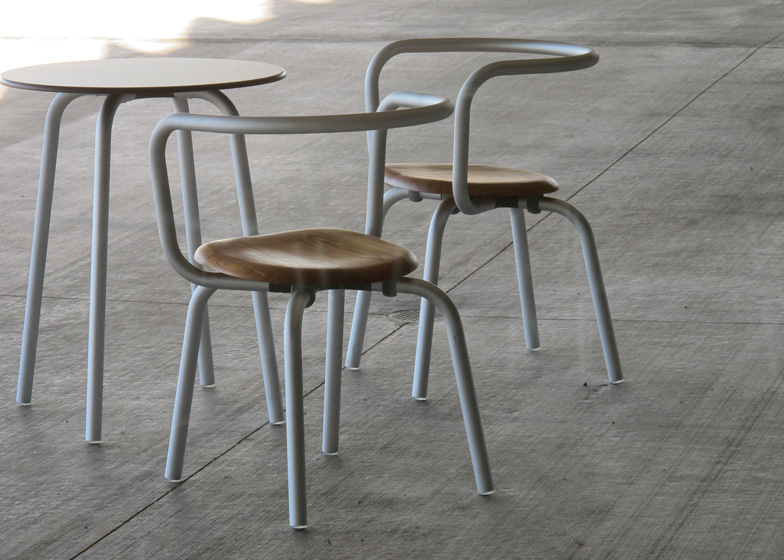Industrial designer Konstantin Grcic worked with furniture brand Emeco to create the chairs and tables that furnish the new Parrish Art Museum on Long Island, recently completed by Swiss architects Herzog & de Meuron.
The Parrish Art Museum recently moved to a new building by Herzog & de Meuron, a single-storey structure near the town of Southampton that resembles two long, narrow barns placed side by side.
Konstantin Grcic and Emeco's Parrish collection includes a table, chair and lounge chair, all with curving legs made from recycled aluminium and seats made of reclaimed pine.
"The Parrish chair was given a round tube, forming a belt that defines the space around you - a space where you can feel protected," said Grcic, adding that the chair manages to feel spacious while using very little material.
"The pine on the aluminium chair looks almost like tractor seat," he added, "which has something old fashioned and genuine about it."
Above: photograph by Konstantin Grcic
The collection will be launched in Milan next April, with tabletops made of high-pressure laminate rather than pine.
Grcic recently designed a mirror for a poodle as part of the Architecture for Dogs project and also contributed a bench covered in a glass mosaic to an exhibition at the V&A during the London Design Festival.
Above: photograph by Richard Lewin
Famous for its aluminium chairs, the American brand Emeco was founded in 1944 with a commission from the US government to produce the now classic Navy chair, also known as the 1006. Earlier this year we reported on a collection of aluminium chairs designed by French architect Jean Nouvel for Emeco.
See all our stories about chairs »
See all our stories about Konstantin Grcic »
See all our stories about Emeco »
Above: photograph by Richard Lewin
Photographs are by Clo'e Floirat except where stated.
Here's some more information from the museum:
Parrish Art Museum
Mobile interiors by Emeco + Konstantin Grcic
Museum opening Nov. 10, 2012 in Water Mill, NYC, USA
Emeco and Konstantin Grcic collaborate on interior installation at the New Parrish Art Museum in South Hampton, NYC.
"The location on Long Island brings a feeling of countryside and the design process was always defined by finding the most straightforward solution fitting the surrounding - the specific needs for this specific museum in this specific region," Konstantin Grcic reflects.
Based on local materials from local manufacturers, Konstantin Grcic matches recycled aluminium and retrieved timber with the bare building, both as fixed and mobile furniture for the Parrish Art Museum. The interior installation includes tables and chairs created in collaboration with American manufacturer Emeco.
"The collaboration with Emeco was always an important part of the project, something I had in mind as an obvious choice for the kind of furniture we needed. It is simply the only company I could think of who could bring a nice mix for this interior concept, specialists in aluminium, delivering another kind of material appearance, environmentally sound, perfect for the both indoor and outdoor and being such a truly American company - it was a perfect match," Grcic continues.
"When Konstantin asked me if Emeco would be interested in collaborating with him on the Parrish Art Museum I was thrilled. Konstantin is one of the most innovative and original industrial designers of today," says Emeco's CEO Gregg Buchbinder. "Konstantin's degree of perfection combined with his analytical rigour made the product development process deliberate and thoughtful. He managed to leverage our heritage and at the same time push Emeco into the future. The Parrish Chair reminds me of something Le Corbusier might have designed in the 1920s, yet at the same time, it looks fresh, modern, and original – it's a real artifact of our current culture, a future classic," Buchbinder continues.
"I have always had a fascination and admiration of the hard physical labour of the production of the Emeco’s iconic Navy chair. My ambition for the collaboration was, therefore, to do something that uses the same aluminium work but make the process more effective, less physically challenging. I think the design of the Parrish chair comes from a close understanding of what Emeco really can do," says Konstantin.
"Developing the mobile interiors for the Parrish museum brings us to the peculiar psychology around chairs used in public spaces – exploring the idea of comfort and non-comfort. The best you can give someone in a public space is a chair that really feels like a chair. Considering the public self-awareness in a museum seat, the Parrish chair was given a round tube, forming a belt that defines the space around you - a space where you can feel protected. The chair is also spacious, achieved using very little material. Put together the pine on the aluminum chair looks almost like tractor seat, which has something old fashioned and genuine about it. At the final installation the Parrish chairs are strong individuals, yet the collection, I must say, looks even greater in multiplication. A density of tube forms composed in a very nice subtle way, an astonishing view in numbers," Konstantin concludes.

